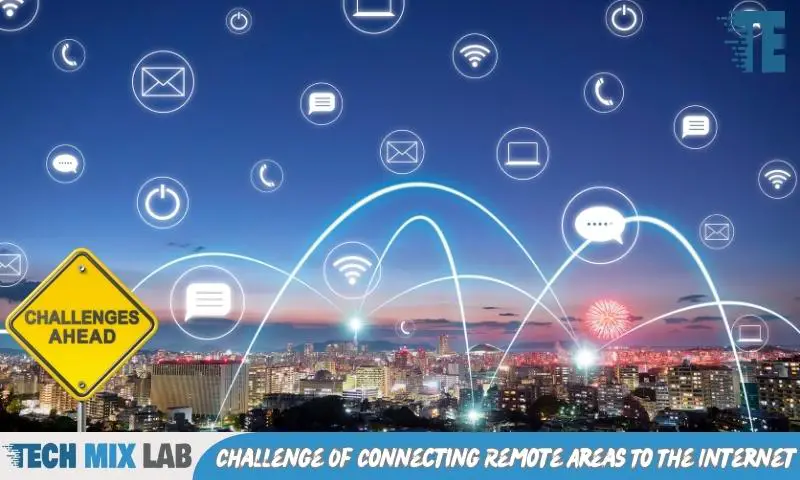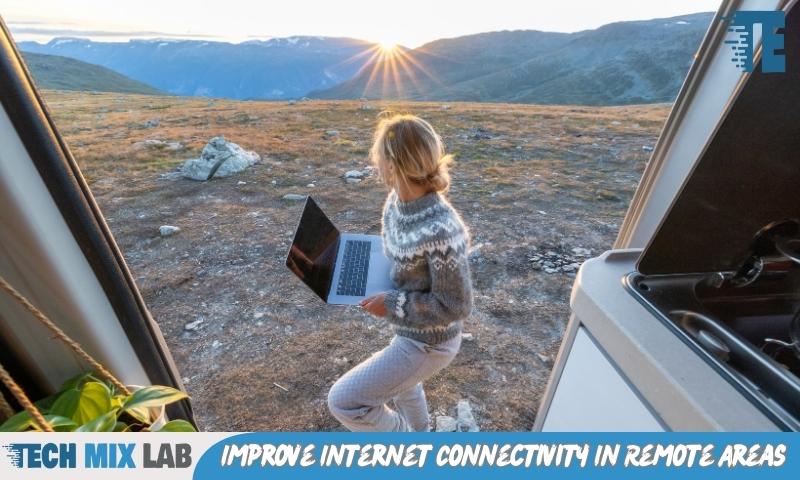To get good internet in the middle of nowhere, consider investing in a satellite internet connection or a cellular network hotspot. Having reliable internet access is crucial in today’s world, especially with remote work and online learning becoming increasingly popular.
However, many people living in rural or isolated areas struggle with slow or nonexistent internet connections. Thankfully, there are options available to help remedy this issue. One option is to invest in a satellite internet connection, which uses satellites in space to provide internet access.
Another option is to use a cellular network hotspot, which allows you to connect to the internet using your smartphone or other device. These solutions can provide faster and more reliable internet access, even in the middle of nowhere. In this article, we’ll explore these options in more detail and provide some tips for choosing the right one for your needs.
Understanding The Challenge Of Connecting Remote Areas To The Internet

The Importance Of Internet Connectivity In Remote Areas
In today’s digitally connected world, internet connectivity has become an essential utility, without which many remote areas are left in the lurch. The Internet provides access to information, education, health services, and employment opportunities, among other essential services. Lack of internet connectivity in remote areas can lead to social exclusion and economic inequality and hinder the growth of these areas.
Benefits Of Internet Connectivity In Remote Areas
- Improved access to education through online classes, research materials, and collaborations with academic institutions.
- Access to telemedicine, video conferencing, and e-health services reduces the need to travel long distances to access healthcare facilities.
- Improved communication among people in remote areas for social, business, and political purposes.
- Creation of employment opportunities, especially for freelancers and those providing services online.
Why Reliable Internet Connections Are Challenging In Remote Areas
Reliable internet connections in remote areas are the primary obstacle to internet connectivity. This challenge results from a combination of factors that companies providing internet services need to consider and address.
Inadequate Infrastructure
- Lack of physical network infrastructure such as fiber optic cables, cellular and microwave towers, satellite internet receivers, or other broadband transmission equipment.
- The terrain in remote areas is rugged, with limited or no access roads and rough terrain, making it difficult to install these infrastructure facilities.
Limited Power Supply
- Access to reliable power supply is crucial to providing an uninterrupted internet connection.
- Power supply infrastructure, such as electricity grids and solar power units, is often inadequate in remote areas, making it a significant challenge for internet service providers in these areas.
Factors That Affect Internet Connectivity In Remote Areas
Connectivity challenges in remote areas are not limited to the inadequacy of infrastructure and power supply; other factors can also impact internet connectivity in remote areas.
Weather Conditions
- Weather patterns such as heavy rainfall, snowfall, and strong winds can disrupt the power supply and affect the performance of satellite internet receivers and other transmission equipment.
Availability Of Service Providers
- The availability of internet service providers in remote areas is limited and insufficient, and the few available service providers may be unwilling to extend their services to remote areas due to small markets and challenging terrain.
Government Regulations And Policies
- Lack of government support and favorable policies might hinder private sector investments in building infrastructure and providing internet services in remote areas.
Connecting remote areas to the Internet is crucial to enhancing their social, economic, and educational growth. Internet service providers need to consider factors such as infrastructure, power supply, weather conditions, service availability, and government policies when providing Internet services to remote areas.
Innovative Technologies That Can Help Improve Internet Connectivity In Remote Areas

Innovative technologies that can help improve internet connectivity in remote areas
Are you tired of slow internet in remote areas? Don’t worry; there are innovative technologies that can help improve internet connectivity in those areas. In this blog post, we will discuss two of these technologies: satellite internet and mesh networks.
Satellite Internet
Satellite internet is an internet service that uses satellite communication to provide internet access to remote areas. Here are some advantages and potential issues with using satellite internet:
Advantages Of Satellite Internet
- Provides internet access to remote areas where other types of internet services are not available.
- It can be installed quickly and easily.
- The speed of satellite internet is faster than dial-up, which is the only option available in some remote areas.
Potential Issues With Satellite Internet
- The cost of satellite internet can be higher compared to other types of internet services.
- Data caps are typically lower than those for other types of internet services.
- Weather conditions can affect satellite internet connectivity.
Mesh Networks
A mesh network is a group of devices that connect wirelessly to each other and create a network. Here is some information about mesh networks:
What Are Mesh Networks, And How Do They Work?
- Mesh networks use a decentralized approach to connect devices to each other instead of one central access point.
- Devices in a mesh network act as nodes, and they all work together to ensure that data is transmitted efficiently.
Advantages Of Mesh Networks
- Mesh networks can provide internet access to remote areas where other types of internet services are not available.
- As devices act as nodes, users can move freely without interrupting the network’s connectivity.
- Mesh networks can provide more reliable connectivity compared to other types of internet services.
Potential Issues With Mesh Networks
- The cost of setting up a mesh network can be high compared to other types of internet services.
- As devices act as nodes, the more devices connected to the network, the slower the internet connectivity can become.
- Signal interference from other wireless devices can affect the connectivity of mesh networks.
Both satellite internet and mesh networks can improve internet connectivity in remote areas. However, users need to consider the advantages and potential issues of each technology before deciding which one to use.
Strategies To Improve Internet Connectivity In Remote Areas
Living or working in a remote area can be quite a challenge when it comes to getting good internet. However, the good news is that there are different strategies that can be pursued to improve internet connectivity in remote areas.
In this section, we will explore the main strategies for improving internet connectivity in remote areas.
Government Initiatives
Governments have a role to play in ensuring that their citizens have access to good internet connectivity. Here are the key points to consider regarding government initiatives:
- Governments have an important role to play in providing internet connectivity to remote areas.
- Government initiatives can help fund the development and installation of internet infrastructure in remote areas.
- Government initiatives can help lower the cost of accessing the internet for remote residents.
- Some government initiatives can be successful in improving internet connectivity in remote areas.
Examples Of Successful Government Initiatives
Here are some examples of government initiatives that have been successful in improving internet connectivity in remote areas:
- The Federal Communications Commission’s (FCC) Connect America Fund (CAF) has provided $10 billion to support the build-out of broadband networks in underserved areas.
- The Australian Broadband Guarantee (ABG) provided subsidies of up to $2,750 for internet access in remote areas.
- The Irish government’s national broadband plan aims to deliver high-speed broadband to every home, farm, and business in the country.
Potential Limitations Of Government Initiatives
Here are some potential limitations to government initiatives:
- Limited funding can lead to slow progress in the deployment of internet infrastructure.
- Bureaucracy and red tape can slow down the implementation of government initiatives.
- Government initiatives can be subject to political interference.
- Government initiatives can be slow to adapt to changing technology and market conditions.
Public-Private Partnerships
Public-private partnerships (PPPs) are collaborations between government bodies and private sector companies. Here are the key points to consider regarding PPPs:
- Public-private partnerships can leverage the strengths of both the government and private sectors to improve internet connectivity in remote areas.
- PPPs can provide the necessary funding and expertise to develop and implement internet infrastructure in remote areas.
- PPPs can encourage innovation and competition in the industry.
Advantages Of Public-Private Partnerships
Here are some advantages of PPPS:
- PPPs can use the private sector’s business models to build and maintain internet infrastructure.
- PPPs can help lower the cost of delivering internet connectivity to remote areas.
- PPPs can help ensure the sustainability of internet infrastructure in remote areas.
Potential Issues With Public-Private Partnerships
Here are some potential issues that may arise with PPPs:
- PPPs can be undermined by conflicting priorities between government bodies and private sector companies.
- PPPs can be prone to legal and regulatory issues.
- PPPs can lead to the loss of control over the ownership and management of internet infrastructure in remote areas.
Community-Based Initiatives
Community-based initiatives involve local residents and businesses taking action to improve internet connectivity in their areas. Here are the key points to consider regarding community-based initiatives:
- Community-based initiatives can help bridge the digital divide in remote areas.
- Community-based initiatives can be cost-effective and efficient.
- Community-based initiatives can foster community engagement and ownership.
Advantages Of Community-Based Initiatives
Here are some advantages of community-based initiatives:
- Community-based initiatives can build a sense of community and mutual support.
- Community-based initiatives can adapt to local needs and circumstances.
- Community-based initiatives can have a positive impact on the local economy.
Potential Challenges With Community-Based Initiatives
Here are some potential challenges that may arise with community-based initiatives:
- Community-based initiatives can be limited by lack of expertise and funding.
- Regulatory and legal concerns may pose a threat to community-based initiatives.
- Community-based initiatives can be subject to internal conflict and disagreements.
Improving internet connectivity in remote areas is crucial for social and economic development. Governments, private sector companies, and local communities all have a role to play in ensuring access to good internet connectivity. By pursuing different strategies and initiatives, it is possible to bridge the digital divide and create a more connected world.
Overcoming Challenges: Best Practices For Improving Reliable Internet Connectivity In Remote Areas
Are you tired of poor internet connectivity in the middle of nowhere? Well, you are not alone. Almost every remote area faces challenges when it comes to internet connectivity. It can be quite frustrating, especially when you need to work or study online.
But don’t worry; in this blog post, we’ll be outlining some best practices to improve internet connectivity in remote areas.
Improving Infrastructure And Network Architecture
The first step in improving internet connectivity in remote areas is to improve the infrastructure and network architecture. This involves upgrading the existing network and building new towers and base stations to expand coverage. Here are some key points to consider when improving the infrastructure and network architecture:
- Upgrade existing equipment and infrastructure to the latest technological standards.
- Build new towers and base stations in strategic locations to expand coverage.
- Ensure that network equipment is maintained and regularly upgraded to prevent downtime and slow internet.
Engaging Community Members And Encouraging Collaboration
Engaging community members and encouraging collaboration is another vital step in improving internet connectivity in remote areas. It’s essential to create a sense of community around the issue and work together to find solutions. Here are some key points to consider when engaging community members and encouraging collaboration:
- Create community groups to discuss the issue and share ideas.
- Encourage collaboration between community groups, internet service providers, and local businesses.
- Lobby governmental and non-governmental agencies to invest in internet infrastructure in remote areas.
Leveraging Existing Resources And Technologies
In remote areas, it’s essential to leverage existing resources and technologies to improve internet connectivity. This involves finding ways to use what is already available to enhance connectivity. Here are some key points to consider when leveraging existing resources and technologies:
- Use satellite internet if no other options are available.
- Utilize existing wired connections, like landlines, to boost connectivity.
- Make use of Wi-Fi mesh networks and range extenders to expand coverage.
Securing Funding For Projects
Securing funding is the last critical step in improving internet connectivity in remote areas. Expanding internet connectivity requires investment, so securing funding is vital to ensuring that projects can be completed effectively. Here are some key points to consider when securing funding for a project:
- Create detailed project proposals and cost analyses to present to potential investors.
- Seek out governmental and non-governmental grants that can help fund projects.
- Work together with internet service providers to find ways to fund projects.
Improving internet connectivity in remote areas is a challenging task, but it’s not impossible. By improving infrastructure and network architecture, engaging community members and encouraging collaboration, leveraging existing resources and technologies, and securing funding for projects, you will be well on your way to achieving reliable internet connectivity in remote areas.
FAQ
How Can I Get Good Internet In Remote Areas?
Getting good internet in remote areas can be challenging, but it’s possible through satellite internet or hotspots.
What Are The Benefits Of Satellite Internet?
Satellite internet provides reliable, high-speed internet even in remote areas without traditional broadband. It also offers a wider coverage area.
How Do I Choose The Right Hotspot For Me?
When choosing a hotspot, consider factors such as network coverage, speed, data usage limits, and pricing plans to find the best fit for your needs.
Conclusion
From this article, you’ve learned that getting good internet in the middle of nowhere is not impossible. With various options at your disposal, it’s important to find the one that works best for you based on factors such as budget, location, and internet requirements.
You can go for satellite internet, which offers faster speeds and wider coverage but comes with higher costs. Alternatively, you could consider setting up a Wi-Fi hotspot using your mobile device or investing in a booster or antenna to strengthen your existing connection.
Whatever option you choose, it’s important to check for any data caps, latency issues, and network coverage before making a final decision. By following these tips and suggestions, you’ll be able to get good internet in the middle of nowhere, allowing you to work, stream, and stay connected seamlessly.





